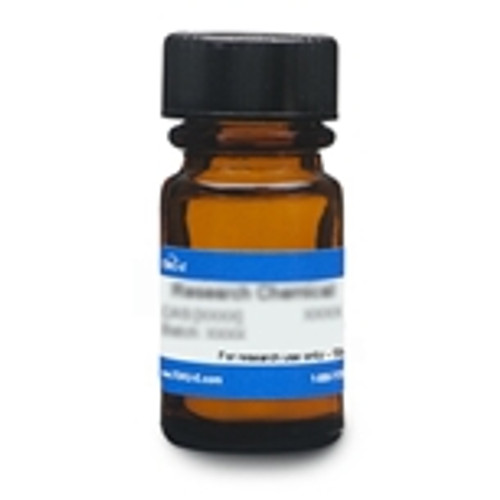Fosfomycin Tromethamine (syn: Fosfomycin Trometamol) is the tromethamine salt form of Fosfomycin, a synthetic, broad-spectrum organophosphonate antibiotic with in vitro activity against most urinary tract pathogens. It is particularly active against E. coli, Citrobacter, Enterobacter, Klebsiella, Serratia and Enterococcus spp. Fosfomycin, originally named phosphonomycin, was discovered in 1969 jointly by Merck and CEPA, in Spain. It was first isolated from broth cultures of Streptomyces fradiae isolated from soil samples. Fosfomycin Tromethamine is soluble in DMSO.
We also offer:
| Mechanism of Action | Fosfomycin Tromethamine inhibits bacterial cell (peptidoglycan) synthesis. Specifically, it inhibits uridine diphospho-N-acetl-D-glucosamine enolpyruvyl transferase (MurA), thereby blocking the condensation of uridine diphosphate-N-acetylglucosamine, one of the first steps in peptidoglycan synthesis. The complete fosfomycin gene cluster from S. fradiae has been closed and sequenced, and the heterologous production in S. lividans has been achieved (Woodyer et al, 2006). |
| Spectrum | Broad spectrum against both Gram-positive and Gram-negative pathogens. It is active against E. coli (including extended spectrum B-lactamase-producing E. coli), Citrobacter, Enterobacter, Klebsiella, Serratia and Enterococcus. |
| Microbiology Applications | Fosfomycin is commonly used in microbiological antibiotic susceptibility tests (panels, discs, and MIC strips) and rapid antimicrobial testing platforms. Medical microbiologics use this information to recommend antibiotic treatement options. Representative MIC ranges include:
|
| Eukaryotic Cell Culture Applications | The effect of Fosfomycin on the immune system, specifically the in vitro function of human T cells, was examined and was found to influence the late stage of T-cell activation. It inhibited the proliferation of human lymphocytes induced by polyclonal T-cell mitogens. It suppressed mixed lymphocyte reaction and the production of interleukin-2 by T-cells. Fosfomycin also inhibited the expression of IL-2 receptor and transferrin receptor on T-cell surfaces. This property widens the therapeutic indices as it could be combined with immunosuppressants in organ transplantation (Morikawa et al, 1993). |
| References | Baum EZ et al (2001) Identification and characterization of new inhibitors of the Escherichia coli MurA enzyme. Antimicrob. Agents Chemother. 45(11):3182-3188 PMID 11600375 de Cueto M et al (2006) In vitro activity of Fosfomycin against extended-spectrum—lactamase producing Escherichia coli and Klebsiella pneumoniae: Comparison of susceptibility testing procedures. Antimicrob. Agents and Chemother 50:368-370 Falagas ME and Kastaris AC (2010) Fosfomycin for the treatment of multidrug-resistant, including extended-spectrum β-lactamase producing, Enterobacteriaceae infections: A systematic review. Lancet Infect. Dis. 10(1): 43-50 PMID 20129148 Grif K et al (2001) In vitro activity of Fosfomycin in combination with various antistaphylococcal substances. J Antimicrob. Chemother 48:209-217 Kahan FM et al (1974) The mechanism of action of Fosfomycin (phosphonomycin) Ann. NY Acad Sci. 235:364-386 Patel SS, Balfour JA and Bryson HM (1997) Fosfomycin Tromethamine. A review of its antibacterial activity, pharmacokinetic properties and therapeutic efficacy as a single-dose oral treatment for acute uncomplicated lower urinary tract infections. Drugs 53(4):637-656 Morikawa K, Oseko F, Morikawa S, Sawada M(1993) Immunosuppressive activity of Fosfomycin on human T-lymphocyte function in vitro. Antimicrob. Agents Chemother. 37(12): 2684-2687 PMID 7509146 Woodyer RD et al (2006) Heterologous production fo Fosfomycin and identification of the minimal biosynthetic gene cluster. Chem. Biol. 13(11):1171-1182 PMID 17113999 |




